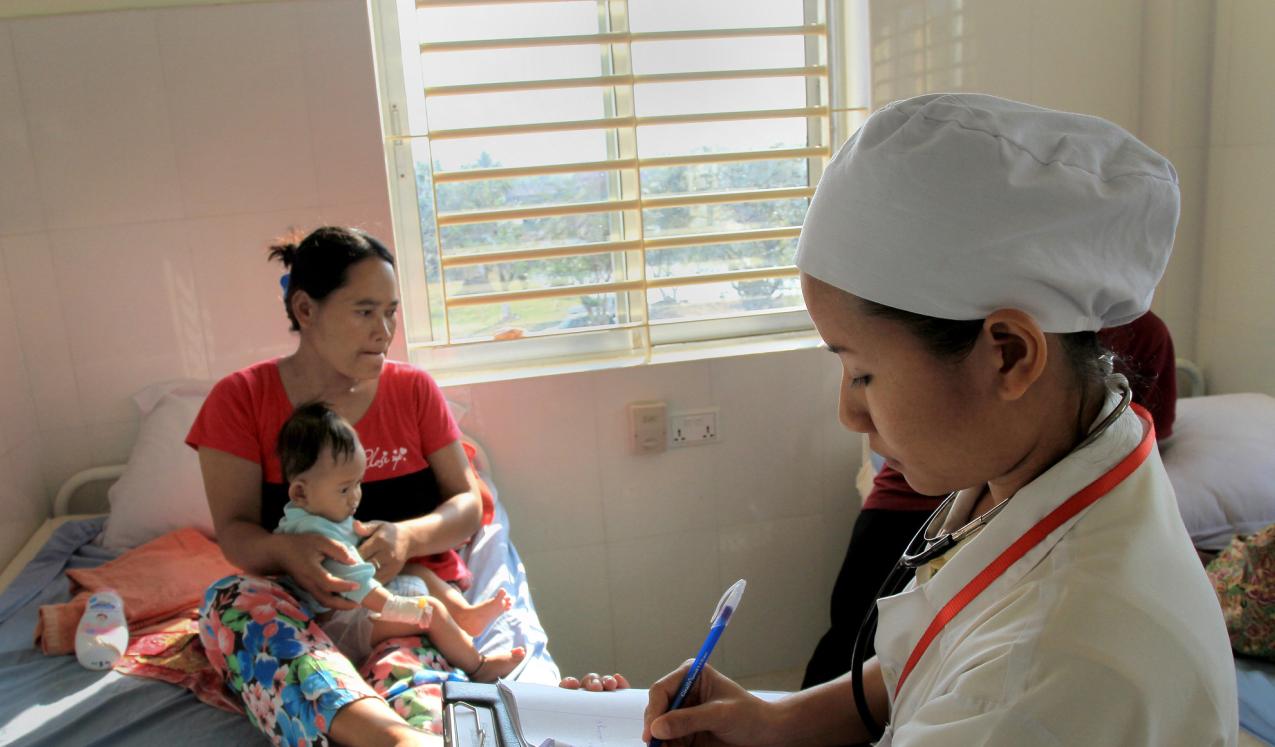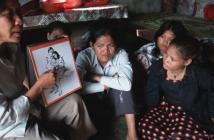
Gender norms and health systems
Gender norms are entrenched in every society and are reflected and reinforced in the ways institutions and systems are structured and interact with people every day. The health system is a prime example.
There are two main ways in which gender norms are expressed in – and compromise – health outcomes and system effectiveness: service provision and labour force. Gendered service provision, for example, means that those seeking health care may not receive the treatment they need if they do not conform to prevalent gender stereotypes. At the same time, a gendered labour force within the health service means that the distribution and value of roles within the service are not distributed evenly by gender. As a result, women accessing health services face a multitude of factors that hinder their ability to receive the treatment they need in a dignified and respectful way.
Norm-setting health governance bodies, such as the World Health Organization and the United Nations General Assembly, have identified 'addressing gender norms in the healthcare field' as vital to improve health outcomes and achieve gender equity. To improve service provision to women, interventions should be women-centred, trauma-informed and consider the lived experiences of women seeking treatment. In relation to gender norms in the health labour force, evidence-based strategies show that the recruitment, retention and upward mobility of women in decision- and policy-making positions have a transformative effect on gender norms in health systems and improve health outcomes.
Men and their interactions with health systems are also informed by gender norms that may make them vulnerable to stigma, discrimination and ill-health. The literature has thoroughly determined that men are much less likely to seek preventive or treatment health services and argues that this is a factor in their shortened lifespans when compared to women. Male engagement strategies are usually focussed on the role of fathers in improving maternal, neonatal and childhood health and in broader family planning services. Furthermore, Western media sources have encouraged the uptake of traditionally female-dominated roles in health, such as nursing and social work, by men and male students.
LGBTQ people face poor treatment, discrimination and disengagement from health systems
Lesbian, gay, bisexual, transgender and queer (LGBTQ) people face poor treatment, discrimination and disengagement from health systems because they do not conform to gender norms. One major obstacle to their access to health care is the strained relationship between health provider and patient. The key elements that have been found to improve such relationships are awareness raising and training, compliance with anti-discrimination legislature and creating a more inclusive setting through gender-neutral bathrooms and non-normative gender options in forms.
The three examples presented below explore promising interventions and policy developments to mitigate institutionalised gender norms in health systems. Dubin et al. (2018) investigate the effectiveness of transgender and gender non-conforming education and training for medical students in North American universities, while Downe et al. (2018) examine the interventions that had the greatest success in improving respectful maternal care in four African nations. Finally, van der Berg et al. (2015) discuss the South African national family planning policy that aims to better address male partner involvement in the prevention of mother-to-child HIV transmission.
Transgender health care: improving medical students' and residents' training and awareness (2018)
Transgender and gender nonconforming (TGNC) people often report poor treatment and health outcomes when seeking medical treatment from healthcare systems. TGNC people are conceptualised by some as being 'gender deviant,' as their gender does not correspond to their assigned sex at birth. For this reason, they are viewed as a threat to wider heteronormative society and its gendered value systems, beliefs and ideals. So when it comes to the healthcare system, TGNC people face discrimination, violence or lack of appropriate treatment by medical staff who often lack the awareness, training or knowledge to provide proper treatment to people of non-normative gender expressions.
A review paper from Dubin et al. (2018) based on 131 papers found that the majority (52%) of North American undergraduate and graduate medical education programmes did not include any LGBTQ training. When LGBTQ health topics were part of curricula, they were taught as if LGBTQ people were one aggregated population and inter-group differences were not looked at in any detail. In undergraduate medical education courses, only 31% of studies contained transgender-specific content and none included training specific to gender nonconforming people.
Because this is a new and emerging field of study, no consensus was established for the most effective training techniques that would improve the knowledge, attitudes and skills of medical students around health care for TGNC people. However, commonalities across different interventions showed promising results. These interventions included: mandatory in-class or optional lunchtime series to teach TGNC-specific political and social issues; assessing patient anatomy before and after gender-affirming surgeries; and the ability to take sexual histories, and examine and discuss hormone therapies with patients.
As a result of these interventions, the findings show a significant and marked increase in knowledge
As a result of these interventions, the findings show a significant and marked increase in knowledge about TGNC people, transgender health practices, and gender and sexuality ideologies. Medical students also reported feeling less discomfort in treating TGNC people and a reduction in transphobic views.
It is important to note, however, that the results were based on survey data from medical students who have undergone the programming, and it is not certain that these students will maintain their new and improved perspectives once they have joined the medical labour force. In addition, the review does not include the experiences of TGNC people when accessing the healthcare system and whether the interventions resulted in their adequate treatment and care by service providers. Nonetheless, the paper presents promising results for TGNC people who do not adhere to traditional gender norms and reflects a growing interest from the health community to better understand and serve TGNC people and meet their specific health needs.
Effectiveness of respectful care policies for women using routine intrapartum services: a systematic review (2018)
Reports of disrespect and abuse from women undergoing childbirth have become an increasingly prominent public health issue in recent years. Disrespect and abuse fall under the umbrella term of 'obstetric violence’, or violence during childbirth through derogatory comments, over-medicalisation, lack of consent to medical procedures and, at times, physical violence from medical staff. Obstetric violence represents a form of institutionalised violence against women within the health system, with women attacked and victimised at a time of acute vulnerability, which may well deter them from using the health service in the future.
In their systematic review on the topic, Downe et al. (2018) identify five studies in settings where respectful maternal care (RMC) policies were enacted (Kenya, South Africa, Sudan and Tanzania), and examine their impact on women's experiences of disrespect and abuse during childbirth. The systematic review presents the findings as evaluations of these policies and their uptake by health providers. RMC policy was defined as increasing ‘staff attitudes and behaviours that respect women’s basic dignity, privacy, and autonomy, the right to consent, and the right not to be exposed to verbal or physical abuse, neglect, or detention.’ Three of the studies took place in hospitals, with the evaluation including data collection at baseline and endline. The remaining two involved multiple sites with a control group that did not receive any intervention.
The policies that were reviewed included: training maternal care providers in respectful care principles; community education programmes to increase women's knowledge about the in-facility service and care that would be provided; infrastructural changes to increase privacy; and exit surveys from mothers who delivered in the hospital. In one intervention in South Africa, women received counselling on the importance of birth companionship, or encouraging male partners to accompany women to childbirth to promote a more woman-friendly service. The intervention sites also included multimedia campaigns through posters, banners and videos, to promote birth companionship and shift the norms dictating that men should not participate in the birthing process.
Results showed women were far more likely to report respectful care during their hospital stay
This norm change increases their presence in the delivery room and allows them to act as advocates for their female partners while they are in such a vulnerable position during birth. The results showed that women were far more likely to report respectful care during their hospital stay and measurably reduced disrespectful or abusive care and physical abuse. In terms of clinical outcomes, one study found that RMC policies reduced episiotomy (a surgical cut at the opening on the vagina during childbirth, performed routinely or liberally in cases of obstetric violence) by 13%.
The review shows that implementing respectful maternal care policies improve the experiences of women accessing healthcare facilities during childbirth, and diminish gender norms that see institutionalised violence against women as acceptable.
Improving Men’s Participation in Preventing Mother-to-Child Transmission of HIV as a Maternal, Neonatal, and Child Health Priority in South Africa (2015)
Involving male partners in maternal and childhood health has been shown to improve health outcomes for women and children, increase men’s own health-seeking behaviours, improve their communication with female partners and make them more involved fathers.
Preventing mother-to-child HIV transmission (PMTCT) is one of the main goals for improving maternal and child morbidity in sub-Saharan Africa. Historically, outreach has targeted only women and has largely ignored the gender norms that shape the decision-making power men hold in these settings. Actively targeting men in the outreach process not only improves the health of their family members, but also has the potential to reduce mortality and morbidity by dispelling the stigma associated with men engaging with health systems for maternal and childcare issues.
In their 2015 study, van den Berg et al. investigate South African family planning policies that enforced the traditional gender norms that do not see maternal health as involving or requiring male participation and that see women as solely responsible for their own health and the health of their children. They note that while the issue of male partner involvement in PMTCT has been raised in multiple recent policies in South Africa, its inclusion is quite limited and is rarely strategised explicitly, alongside comprehensive aims.
Men should be engaged directly as supportive partners
They therefore set out three policy recommendations, all supported by evidence-based best practices. First, men should be engaged directly as supportive partners in maternal, neonatal and child health (MNCH). Methods to achieve this could involve couples' HIV testing as the first step to receiving antenatal care, sending written invitations to male partners to join women during appointments and creating a welcoming and warm learning environment in health centres for men.
Second, MNCH services should target male health needs more effectively. These needs could include male circumcision (an effective method of decreasing HIV transmission) and erectile dysfunction. By including male-specific services, MNCH health centres could change the norm that these are spaces that can be utilised only by women.
Third, community-based campaigns to encourage men to challenge traditional gender norms and gender-inequitable beliefs have demonstrated tremendous success. Civil society organisations should work in conjunction with health services to challenge the idea that men's participation in antenatal care is unmanly and effeminate. Uptake of these policy recommendations has the potential to achieve PMTCT and better integrate men into the healthcare system.



